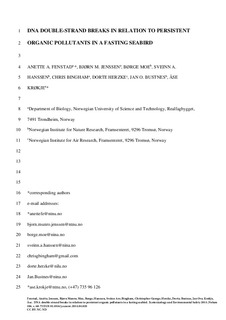| dc.contributor.author | Fenstad, Anette | |
| dc.contributor.author | Jenssen, Bjørn Munro | |
| dc.contributor.author | Moe, Børge | |
| dc.contributor.author | Hanssen, Sveinn Are | |
| dc.contributor.author | Bingham, Christopher George | |
| dc.contributor.author | Herzke, Dorte | |
| dc.contributor.author | Bustnes, Jan Ove | |
| dc.contributor.author | Krøkje, Åse | |
| dc.date.accessioned | 2018-01-23T09:28:17Z | |
| dc.date.available | 2018-01-23T09:28:17Z | |
| dc.date.created | 2014-05-26T14:43:35Z | |
| dc.date.issued | 2014 | |
| dc.identifier.citation | Ecotoxicology and Environmental Safety. 2014, 106 68-75. | nb_NO |
| dc.identifier.issn | 0147-6513 | |
| dc.identifier.uri | http://hdl.handle.net/11250/2478953 | |
| dc.description.abstract | Lipophilic persistent organic pollutants (POPs) are released from fat reserves during fasting, causing increased blood concentrations. Thus, POPs represent a potential anthropogenic stressor during fasting periods. We analysed the blood of female common eiders (Somateria mollissima) by using agarose gel electrophoresis and image data analysis to quantify the DNA-fraction, of total DNA, that migrated into the gel (DNA-FTM) as a relative measure of DNA double strand-breaks (DSBs) during the fasting incubation period in the high arctic. In 2008 and in 2009 blood samples were obtained for analysis of 9 POPs and DNA-FTM at day 5 of the incubation period, and then in the same individuals at day 20. This unique study design gave us the opportunity to analyse the same individuals throughout two points in time, with low and high stress burdens. During the incubation period the body mass (BM) decreased by 21–24%, whereas the POP levels increased by 148–639%. The DNA-FTM increased by 61–67% (being proportional to the increase in DSBs). At day 5, but not day 20, DNA-FTM was positively correlated with most analysed POPs. The increase in DNA-FTM was positively correlated with the decrease in BM (g) during incubation. Thus, we suggest that fasting stress (BM loss) decreases DNA integrity and that stress caused by fasting on BM loss appeared to override the additional stress caused by concurrent increase in levels of the analysed POPs in the eiders. Blood levels of POPs in the eiders in Svalbard were relatively low, and additive and/or synergistic genotoxic effects of fasting stress and POP exposure may occur in populations with higher POP levels. | nb_NO |
| dc.language.iso | eng | nb_NO |
| dc.publisher | Elsevier | nb_NO |
| dc.rights | Attribution-NonCommercial-NoDerivatives 4.0 Internasjonal | * |
| dc.rights.uri | http://creativecommons.org/licenses/by-nc-nd/4.0/deed.no | * |
| dc.title | DNA double-strand breaks in relation to persistent organic pollutants in a fasting seabird | nb_NO |
| dc.type | Journal article | nb_NO |
| dc.type | Peer reviewed | nb_NO |
| dc.description.version | acceptedVersion | nb_NO |
| dc.source.pagenumber | 68-75 | nb_NO |
| dc.source.volume | 106 | nb_NO |
| dc.source.journal | Ecotoxicology and Environmental Safety | nb_NO |
| dc.identifier.doi | 10.1016/j.ecoenv.2014.04.020 | |
| dc.identifier.cristin | 1134953 | |
| dc.relation.project | Norges forskningsråd: 234423 | nb_NO |
| dc.description.localcode | Copyright © 2014 Elsevier Inc. All rights reserved. This is the authors' accepted and refereed manuscript to the article. | nb_NO |
| cristin.unitcode | 194,66,10,0 | |
| cristin.unitname | Institutt for biologi | |
| cristin.ispublished | true | |
| cristin.fulltext | postprint | |
| cristin.qualitycode | 1 | |

